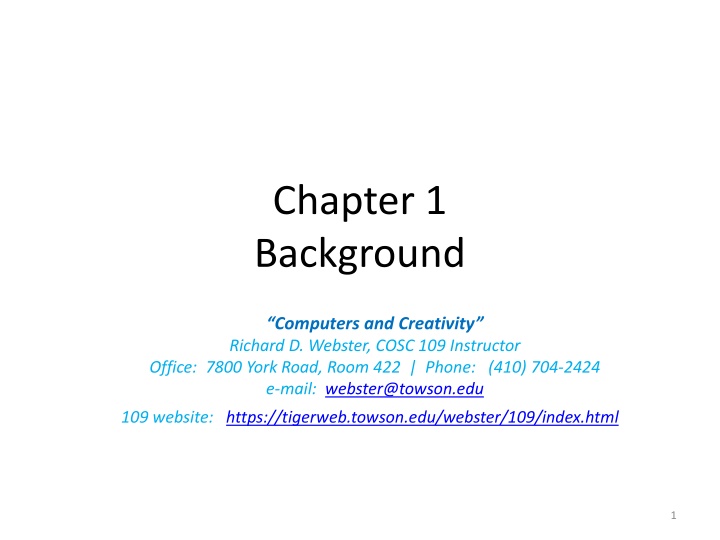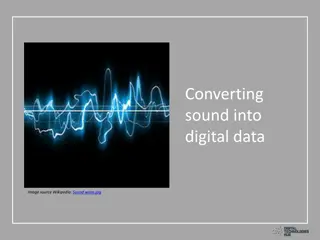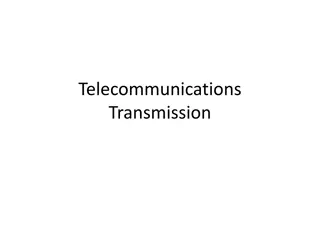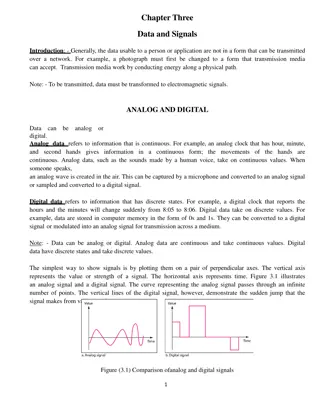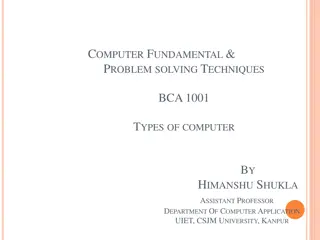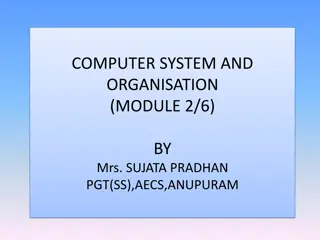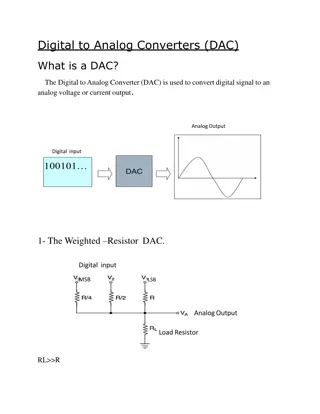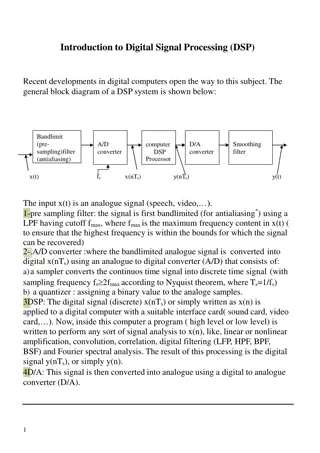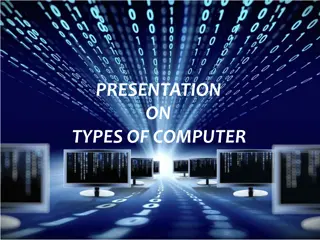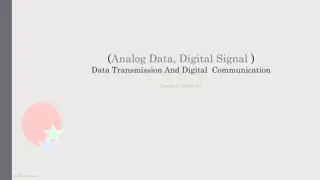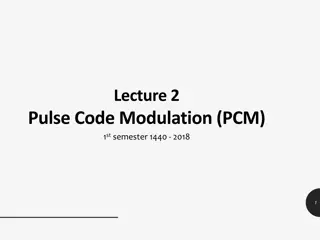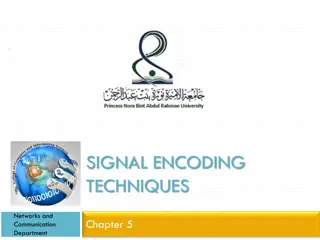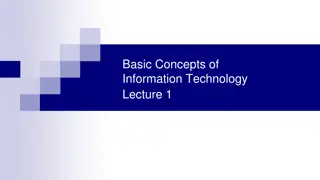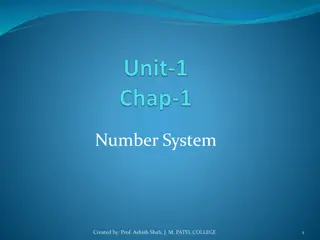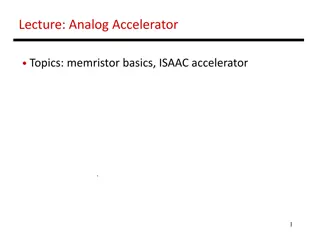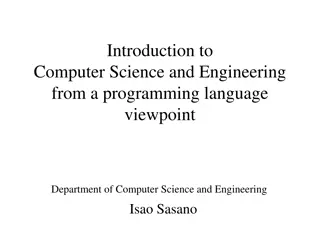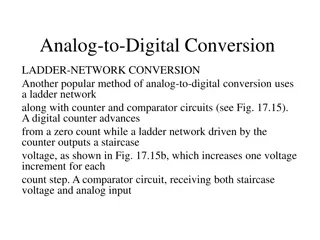Digital and Analog Information in Computers
Explore the concepts of digital and analog information in computers through examples like thermometers, sound, and sight. Learn how computers process discrete digital data compared to continuous analog information, and why understanding both is essential in digital media courses. Delve into the conversion process and scenarios like monitoring a puppy's weight to grasp the significance of these concepts in everyday life.
Uploaded on Oct 11, 2024 | 0 Views
Download Presentation

Please find below an Image/Link to download the presentation.
The content on the website is provided AS IS for your information and personal use only. It may not be sold, licensed, or shared on other websites without obtaining consent from the author.If you encounter any issues during the download, it is possible that the publisher has removed the file from their server.
You are allowed to download the files provided on this website for personal or commercial use, subject to the condition that they are used lawfully. All files are the property of their respective owners.
The content on the website is provided AS IS for your information and personal use only. It may not be sold, licensed, or shared on other websites without obtaining consent from the author.
E N D
Presentation Transcript
Chapter 1 Background Computers and Creativity Richard D. Webster, COSC 109 Instructor Office: 7800 York Road, Room 422 | Phone: (410) 704-2424 e-mail: webster@towson.edu 109 website: https://tigerweb.towson.edu/webster/109/index.html 1
In this lecture, you will find answers to these questions Computers store and transmit information using digital data. What exactly is digital data? Is there anything not digital? Why do we bother to learn about anything not digital in a digital media course? What does digitizing mean? 2
Analog Information Examples: time weight temperature line length sound loudness light brightness color saturation and hue 3
Analog Thermometer vs. Digital Thermometer analog thermometer digital thermometer 4
Analog vs. Digital Analog information continuous made up of infinite number of data points Digital data Discrete (So, analog information is continuous, while digital data is discrete.) 5
Discrete Data Examples: number of persons There is no in-between one person and two persons. choices in multiple-choice questions There is no in-between choice A and choice B. 6
Analog vs. Digital Sight and sound we peceive in our natural world are analog information--continuous and infinite number of points between any two points. Computers handle discrete digital data. In addition, the amount of data has to be finite. Sight and sound must be converted into finite discrete digital data in order for the computer to handle. 7
Before we talk about the conversion process, let's look at a scenario: Monitoring a puppy's weight in his first year 8
Suppose you use an analog scale to weigh the puppy 9
Now, what is the weight you would note down for this puppy? 10
See the problem in picking a number to represent an analog measurement? 11
Number of Decimal Places In recording the weight, you must decide the number of decimal places to use. This determines the precision or exactness of the measurement. How many will give an exact measurement? How many is enough? How many is too many? 12
Using More Decimal Places Pros : increase the precision in general (But how many is meaningful?) Will allow finer distinction between values (will explain in the next slide) Cons: Require more paper and paperwork. Take longer to read through and interpret the numbers. 13
Distinction Between Values With one decimal place: You can have 10 different values between say 2 and 3: 2.1, 2.2, ...3.0 You can distinct between 2.5 and 2.8. But 2.5 and 2.8 would have been rounded to the same value of 3 the values do not allow decimal places. 14
Now, how often would you weigh the puppy to produce a "good" monitoring of his weight over his first year? A. once a year B. once a month C. every two weeks D. every week E. every day F. every hour G. every minute H. every second 15
Considerations in deciding how often to weigh the puppy What happens if you weigh the puppy not often enough? What happens if you weigh the puppy too often? Is there one right answer? Will you use the same weighing schedule to monitor the weight of an adult dog? 16
Digitization (Digitizing) To convert analog information into digital data that computers can handle 2-step process: 1. sampling 2. quantization 17
Sampling Analogous to weighing and recording the puppy's weight During the sampling step, you need to set a sampling rate. Sampling rate: how often you take a data 18
Sampling Rate Weighing Puppy Scenario Digitization Pros: can catch more weight changes Pros: can capture details (e.g. some changes of color within a small region in a picture or amplitude changes in sound within a short period of time) high (i.e. taking data often) Cons: produce more paperwork and thus take longer to read through all the data Cons: produce larger file and thus take longer to process Pros: less paperwork and thus take shorter time to read through all the data Pros: produce smaller file and thus take shorter time to process low (i.e. taking data infrequently) Cons: may miss weight changes Cons: may miss details (e.g. color changes in a picture or changes in sound) 19
Quantization Analogous to rounding the weight to fix number of digits in the weighing puppy scenario During the quantization step, you need to set bit depth. Bit depth refers to the number of allowable levels you map (or round) the values to. 20
Example: 10 levels of weight For 10 discrete levels, you may have the 10 allowable values as 2.0, 2.1, 2.2, 2.3, 2.4, 2.5, 2.6, 2.7, 2.8, and 2.9 0, 5, 10, 15, 20, 25, 30, 35, 40, 45 2, 4, 6, 8, 10, 12, 14, 16, 18, 20 1, 2, 3, 4, 5, 6, 7, 8, 9, 10 increasing the number of allowable levels (i.e. increasing bit depth) will increase the file size. 21
Sampling and Quantization Digitizing media involves sampling and quantization regardless of the type of media: images video audio 22
Overview of how sampling rate and bit depth affect digital media file quality Sampling rate is related to: Bit depth is related to: digital images image resolution, or number of pixels number of allowable colors in an image digital video number of pixels in the video, frame rate number of allowable colors digital audio sampling rate of the audio (it limits how high the pitch of the audio can be captured) number of allowable levels of amplitude Details will be covered in chapters for each media type. 23
Overview of how sampling rate and bit depth affect digital media file quality Sampling rate is related to: Bit depth is related to: digital images image resolution, or number of pixels number of allowable colors in an image You can reduce the file size of digital media by: decreasing the sampling rate, and, decreasing bit depth. 24
Bits In computer systems, data is stored and represented in binary digits, called bits. To understand how bits can be used to store information, let's use eye signals as an analogy. 25
Two eyes, Four Combinations of Open and Closed 26
Encoding Your Eye Signals To communicate with your friends with your eye signals, you will need to assign meanings (or messages) to the different combinations of open and closed eyes. We call this process encoding the message. 27
Decode Your Eye Signals In order to use your eye signals to communicate with your friends, they will need to know how to interpret your eye signals. We call it decoding your eye signals. 28
Bits In computer systems, data is stored and represented in binary digits, called bits. A bit has two possible values, 0 or 1. 29
How many eyes do you need if you have 16 possible colors to signal to your friends? 30
4 bits can encode 16 (24) different messages 31
Number of possible values = 2(number of bits) More bits can encode more information. More bits require more computer storage. 1 byte = 8 bits 32
So Many Bits... The number of bits to encode information especially for digital media are very large. We use prefixes, such as mega and giga, to better conceive the number of bits and bytes of computer storage. 33
Prefixes Prefix Name Abbreviation Size 210 = 1,024 Kilo K 220 = 2,048 Mega M 230 = 1,073,741,824 Giga G 240 = 1,099,511,627,776 Tera T 250 = 1,125,899,906,842,624 Peta P A byte = 8 bits A kilobyte = 1,024 bytes. Note the size is computed by the exponential of 2. The exponent is increased in a step of 10, i.e. 210 , 220 , 230 , 240 , 250 , ... It is NOT 103 , 106 , 109 , 1012 , 1015 , ... 34
Using bits to represent numeric values Decimal Notation Base-10 Commonly used in our daily life Use combinations of 10 different numerals to construct any values The 10 different numerals are: 0, 1, 2, 3, 4, 5, 6, 7, 8, 9 35
Base-10 Example The decimal number 5872 is interpreted as follows. 5 0 8 0 0 7 0 0 0 + 2 5 8 7 2 36
Using bits to represent numeric values Binary Notation Base-2 Used in machine language (language that computers understand) Use combinations of 2 different numerals to construct any values The 2 different numerals are: 0, 1 37
Base-2 Example The binary notation 1011 is interpreted as follows. 1 0 1 1 = 1 x 23 + 0 1 x 21 + 1 x 20 x 22 + = 1 x 8 + 0 1 x 2 + 1 x 1 x 4 + = 8 = 11 (eleven, in decimal notation) + 0 2 + 1 + 38
Using bits to represent text For example, the character A is represented by 65. 39
Using bits to represent images Bitmap images, such as digital photos color value of each pixel encoded into bits Vector graphics, such as graphics created in Flash coordinates of anchor points encoded into bits tangent of each anchor points encoded into bits Bitmap images, vector graphics, and pixels will be explained in the digital images chapters 40
Using bits to represent sound sampled audio amplitude for each sample encoded into bits For CD quality audio, it has 44,100 samples per second of the audio MIDI music each musical instrument has an ID which can be encoded into bits each musical note has an ID which can be encoded into bits Sampled audio and MIDI will be explained in the audio chapters 41
File Sizes In a text document that uses ASCII code to represent text characters, each byte stores an ASCII code that corresponds to a character. The more characters in a text document, the more bytes are required to store the file. Digital media files (image, sound, and especially video files) can be very large. 42
Large File Size Disadvantages take longer to copy the file from one computer to another take longer to send the file over the Internet take longer to process (such as during opening and saving) the file Strategies to reduce digital media file size Reduce the sampling rate Reduce the bit depth Apply file compression 43
Reduce Sampling Rate and/or Bit Depth Reduce sampling rate Recall the weighing puppy scenario If you weigh the puppy more frequently, it will take more paper. For digital media files, higher sampling rate means more data to store. In other words, lower sample rate will produce less data, i.e. smaller file size. Reduce bit depth Bit depth refers to the number of allowable levels you can map the data For digital media files, lower bit depth means less data to store. 44
Compression File compression means techniques to reduce file size Two categories in terms of whether the data get lost during the compression: lossy compression lossless compression 45
Lossy Compression Some data will be lost and cannot be recovered Examples: JPEG compression for images MP3 for audio most compressors for videos Avoid using lossy compression (if possible) when you want to keep the file for further editing. Generally, you can do so with images and audio. Video files are generally so large that it is inevitable to save them with lossy compression. 46
Trade-offs of Reducing File Size Data will be lost or altered when you apply these strategies: reduce sampling rate reduce bit depth apply lossy compression When data is lost or altered, you sacrifice the exactness of the media original information. This affects the quality of the media. 47
Weighing the Trade-offs Depend on projects and intended use of the files Weigh the file size (storage requirement and speed of transfer and processing of the file) against the quality of the digital media files Losing data vs. "perceivable" quality Sometimes it may be acceptable if losing data does not cause "perceivable" deterioration in quality 48
Example: MP3 MP3 audio uses a lossy compression. It reduces the file size by selectively removing and altering the audio data (such as certain ranges of audio frequencies) that are not very perceivable by human. 49
